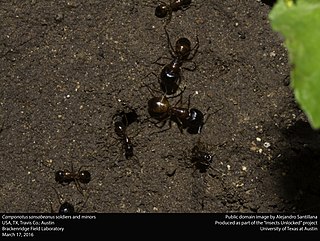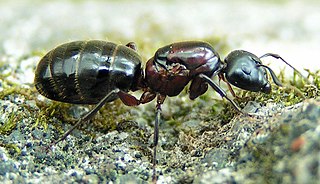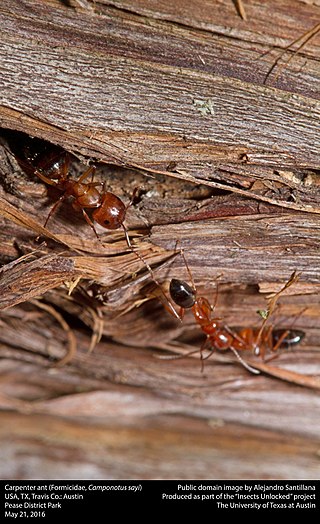
Carpenter ants are large ants indigenous to many forested parts of the world.

The black carpenter ant is one of the largest and most common species of carpenter ant native to the central and eastern United States as well as eastern Canada.

Camponotus atriceps, previously referred as C. abdominalis, is a species of carpenter ant, endemic to the Americas.
Camponotus silvestrii is a species of carpenter ant in the genus Camponotus native to northern Brazil.

Camponotus floridanus, or Florida carpenter ant, is a species of ant in the genus Camponotus. First described as Formica floridana by Buckley in 1866, the species was moved to Camponotus by Mayr in 1886. The ant is widespread in Florida and occurs as far north as North Carolina and as far west as Mississippi.

Camponotus inflatus is a species of carpenter ant native to Australia. Its workers can be used as repletes in a manner similar to honeypot ants, and Aboriginal Australians traditionally eat the repletes as food.

Camponotus sansabeanus is a species of carpenter ant native to the western United States, northern Mexico, Missouri, Arkansas, and Louisiana.

Camponotus mina is a species of carpenter ant native to large parts of northern Mexico, California, Arizona, Texas, and New Mexico, and possibly Wyoming, South Dakota, and Minnesota.

Camponotus vicinus is a species of carpenter ant widespread throughout western North America; it is found from Alaska, south to Mexico, and east to Texas and Manitoba. Unlike its wood-nesting relatives, C. vicinus is typically found nesting in the soil under stones and other objects.

Camponotus discolor is a species of carpenter ant native to the eastern United States, North Dakota, Nebraska, Texas, Kansas, Oklahoma, Nuevo Leon, Tamaulipas, and possibly California, Montana, Utah, and Colorado.

Camponotus chromaiodes, known generally as, the ferruginous carpenter ant or red carpenter ant, is a species of carpenter ant native to the eastern United States, Nebraska, Kansas, and possibly California. Acetobacteraceae are found in the guts of workers in this species.

Camponotus novaeboracensis, the New York carpenter ant, is a species of carpenter ant native to the United States, Canada, possibly found in Costa Rica, Malaysia, and invasive in Bermuda.

Camponotus subbarbatus. also known as the bearded carpenter ant, is a species of carpenter ant native to eastern North America.

Camponotus sayi is a species of carpenter ant native to the southwest United States, northern Mexico, and possibly North Dakota, Ontario, Mississippi, North Carolina, South Carolina, and Florida.

Camponotus clarithorax is a species of carpenter ant of the subgenus Camponotus native to California, Oregon, the Baja California Peninsula, and possibly the eastern United States. This species is found in Oregon, California, and Baja California.

Camponotus sericeiventris, the shimmering golden sugar ant, is a species of carpenter ant native to large parts of Central and South America. It is the only species in the subgenus Myrmepomis.

Camponotus fallax is a species of carpenter ant native to Europe, Asia, northern Africa, and possibly North America and South Korea.

Camponotus inaequalis is a species of carpenter ant native to Florida, the Bahamas, and Cuba.

Myrmentoma, the cleft-lip carpenter ants, is a subgenus of Camponotus, the carpenter ants. Its Nearctic species nest in galls, branches and stems of plants, under tree bark, in wood and buildings, or soil. Colonies are generally small with a few dozen or a few hundred workers.

Camponotus johnsoni is a species of carpenter ant native to California and Baja California.


















